YAMAHA XJR 1300 2015 Owner's Guide
Manufacturer: YAMAHA, Model Year: 2015, Model line: XJR 1300, Model: YAMAHA XJR 1300 2015Pages: 98, PDF Size: 2.6 MB
Page 31 of 98
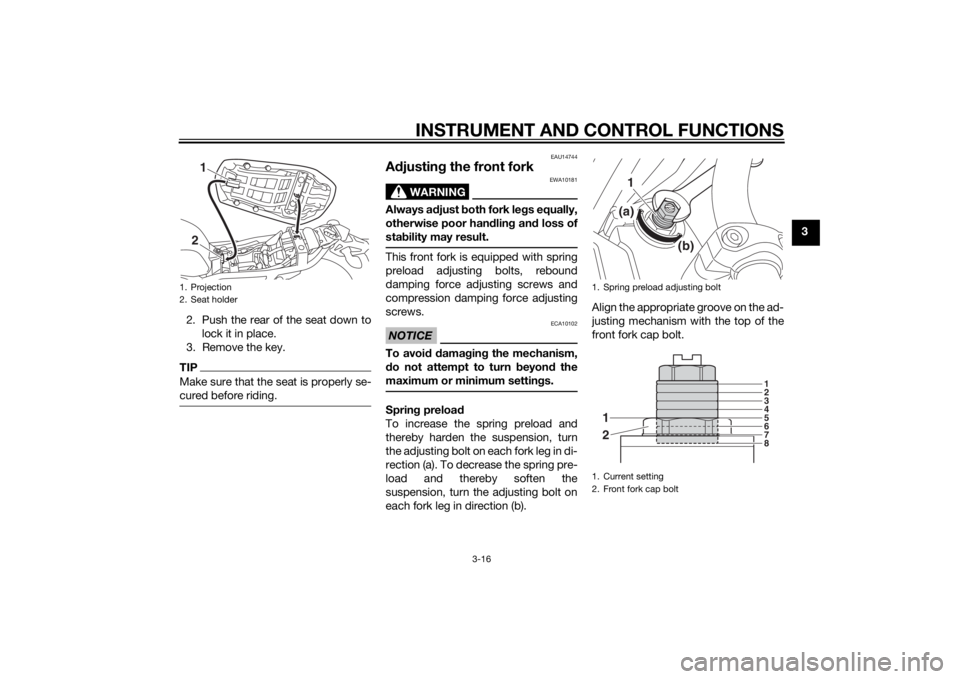
INSTRUMENT AND CONTROL FUNCTIONS
3-16
3
2. Push the rear of the seat down to lock it in place.
3. Remove the key.
TIPMake sure that the seat is properly se-
cured before riding.
EAU14744
A djustin g the front fork
WARNING
EWA10181
Always a djust both fork leg s equally,
otherwise poor han dlin g an d loss of
sta bility may result.This front fork is equipped with spring
preload adjusting bolts, rebound
damping force adjusting screws and
compression damping force adjusting
screws.NOTICE
ECA10102
To avoi d d amag ing the mechanism,
d o not attempt to turn b eyond the
maximum or minimum settin gs.Sprin g preloa d
To increase the spring preload and
thereby harden the suspension, turn
the adjusting bolt on each fork leg in di-
rection (a). To decrease the spring pre-
load and thereby soften the
suspension, turn the adjusting bolt on
each fork leg in direction (b). Align the appropriate groove on the ad-
justing mechanism with the top of the
front fork cap bolt.
1. Projection
2. Seat holder
12
1. Spring preload adjusting bolt
1. Current setting
2. Front fork cap bolt
1(a)
(b)
2 1
1
2
3
4
5
6
7
8
U2PNE0E0.book Page 16 Tuesda
y, September 16, 2014 4:15 PM
Page 32 of 98
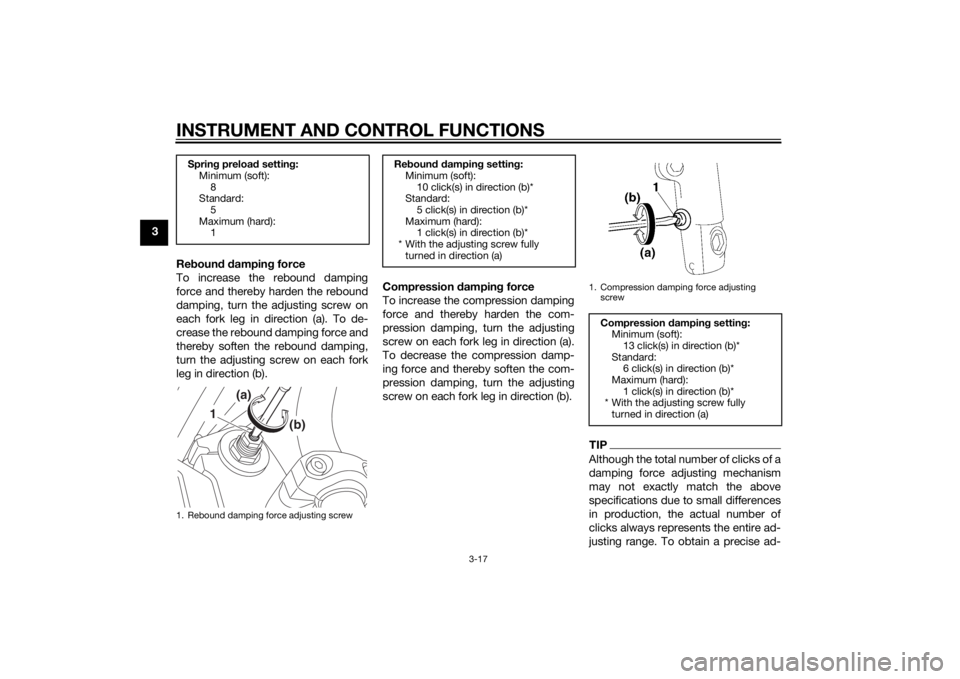
INSTRUMENT AND CONTROL FUNCTIONS
3-17
3Reboun d d ampin g force
To increase the rebound damping
force and thereby harden the rebound
damping, turn the adjusting screw on
each fork leg in direction (a). To de-
crease the rebound damping force and
thereby soften the rebound damping,
turn the adjusting screw on each fork
leg in direction (b). Compression
dampin g force
To increase the compression damping
force and thereby harden the com-
pression damping, turn the adjusting
screw on each fork leg in direction (a).
To decrease the compression damp-
ing force and thereby soften the com-
pression damping, turn the adjusting
screw on each fork leg in direction (b).
TIPAlthough the total number of clicks of a
damping force adjusting mechanism
may not exactly match the above
specifications due to small differences
in production, the actual number of
clicks always represents the entire ad-
justing range. To obtain a precise ad-
Sprin g preloa d setting :
Minimum (soft):
8
Standard:
5
Maximum (hard): 11. Rebound damping force adjusting screw
1
(a)
(b)
Re boun d d ampin g setting :
Minimum (soft):
10 click(s) in direction (b)*
Standard:
5 click(s) in direction (b)*
Maximum (hard): 1 click(s) in direction (b)*
* With the adjusting screw fully turned in direction (a)
1. Compression damping force adjusting
screwCompression dampin g settin g:
Minimum (soft): 13 click(s) in direction (b)*
Standard: 6 click(s) in direction (b)*
Maximum (hard):
1 click(s) in direction (b)*
* With the adjusting screw fully turned in direction (a)
U2PNE0E0.book Page 17 Tuesda y, September 16, 2014 4:15 PM
Page 33 of 98
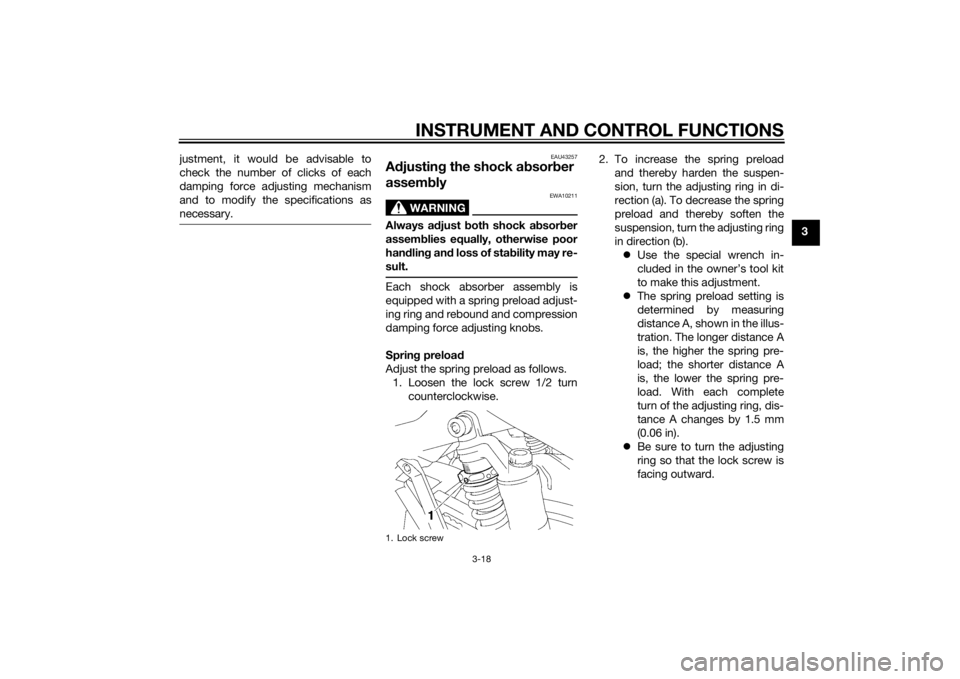
INSTRUMENT AND CONTROL FUNCTIONS
3-18
3
justment, it would be advisable to
check the number of clicks of each
damping force adjusting mechanism
and to modify the specifications as
necessary.
EAU43257
A
djustin g the shock a bsor ber
assemb ly
WARNING
EWA10211
Always a djust both shock ab sorber
assem blies equally, otherwise poor
han dlin g an d loss of stab ility may re-
sult.Each shock absorber assembly is
equipped with a spring preload adjust-
ing ring and rebound and compression
damping force adjusting knobs.
Sprin g preloa d
Adjust the spring preload as follows. 1. Loosen the lock screw 1/2 turn counterclockwise. 2. To increase the spring preload
and thereby harden the suspen-
sion, turn the adjusting ring in di-
rection (a). To decrease the spring
preload and thereby soften the
suspension, turn the adjusting ring
in direction (b). Use the special wrench in-
cluded in the owner’s tool kit
to make this adjustment.
The spring preload setting is
determined by measuring
distance A, shown in the illus-
tration. The longer distance A
is, the higher the spring pre-
load; the shorter distance A
is, the lower the spring pre-
load. With each complete
turn of the adjusting ring, dis-
tance A changes by 1.5 mm
(0.06 in).
Be sure to turn the adjusting
ring so that the lock screw is
facing outward.1. Lock screw
U2PNE0E0.book Page 18 Tuesda y, September 16, 2014 4:15 PM
Page 34 of 98
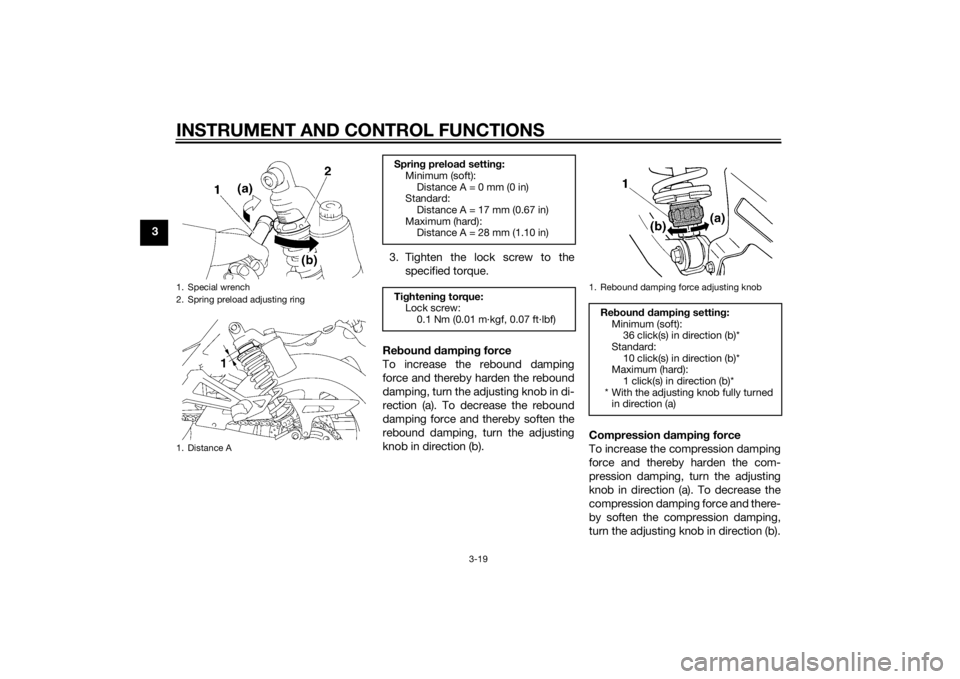
INSTRUMENT AND CONTROL FUNCTIONS
3-19
33. Tighten the lock screw to thespecified torque.
Re boun d d ampin g force
To increase the rebound damping
force and thereby harden the rebound
damping, turn the adjusting knob in di-
rection (a). To decrease the rebound
damping force and thereby soften the
rebound damping, turn the adjusting
knob in direction (b). Compression
dampin g force
To increase the compression damping
force and thereby harden the com-
pression damping, turn the adjusting
knob in direction (a). To decrease the
compression damping force and there-
by soften the compression damping,
turn the adjusting knob in direction (b).
1. Special wrench
2. Spring preload adjusting ring
1. Distance A
Sprin g preloa d setting :
Minimum (soft):
Distance A = 0 mm (0 in)
Standard:
Distance A = 17 mm (0.67 in)
Maximum (hard): Distance A = 28 mm (1.10 in)
Ti ghtenin g torque:
Lock screw:
0.1 Nm (0.01 m·kgf, 0.07 ft·lbf)
1. Rebound damping force adjusting knobRe boun d d ampin g setting :
Minimum (soft): 36 click(s) in direction (b)*
Standard: 10 click(s) in direction (b)*
Maximum (hard):
1 click(s) in direction (b)*
* With the adjusting knob fully turned in direction (a)
U2PNE0E0.book Page 19 Tuesda y, September 16, 2014 4:15 PM
Page 35 of 98
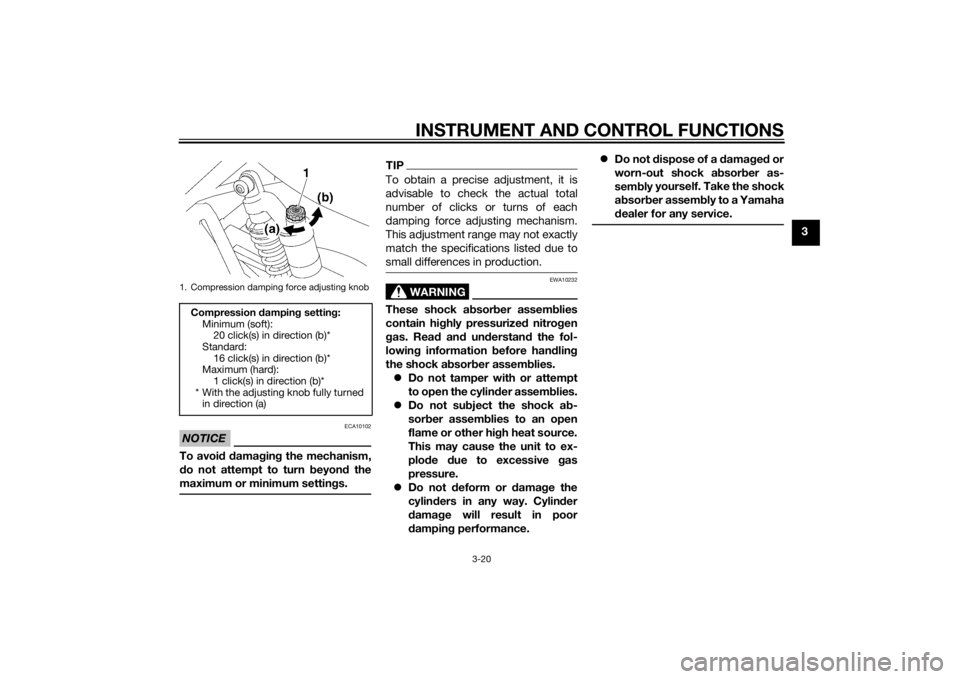
INSTRUMENT AND CONTROL FUNCTIONS
3-20
3
NOTICE
ECA10102
To avoid d amag ing the mechanism,
d o not attempt to turn b eyond the
maximum or minimum settin gs.
TIPTo obtain a precise adjustment, it is
advisable to check the actual total
number of clicks or turns of each
damping force adjusting mechanism.
This adjustment range may not exactly
match the specifications listed due to
small differences in production.
WARNING
EWA10232
These shock ab sorber assem blies
contain hi ghly pressurize d nitro gen
g as. Rea d an d un derstan d the fol-
lowin g information before han dlin g
the shock ab sorber assem blies.
Do not tamper with or attempt
to open the cylin der assem blies.
Do not su bject the shock a b-
sor ber assem blies to an open
flame or other hi gh heat source.
This may cause the unit to ex-
plod e due to excessive gas
pressure.
Do not deform or damag e the
cylin ders in any way. Cylin der
d amag e will result in poor
d ampin g performance.
Do not dispose of a d amaged or
worn-out shock a bsor ber as-
sem bly y
ourself. Take the shock
a b sor ber assem bly to a Yamaha
d ealer for any service.
1. Compression damping force adjusting knobCompression dampin g setting :
Minimum (soft): 20 click(s) in direction (b)*
Standard: 16 click(s) in direction (b)*
Maximum (hard):
1 click(s) in direction (b)*
* With the adjusting knob fully turned in direction (a)
U2PNE0E0.book Page 20 Tuesda y, September 16, 2014 4:15 PM
Page 36 of 98
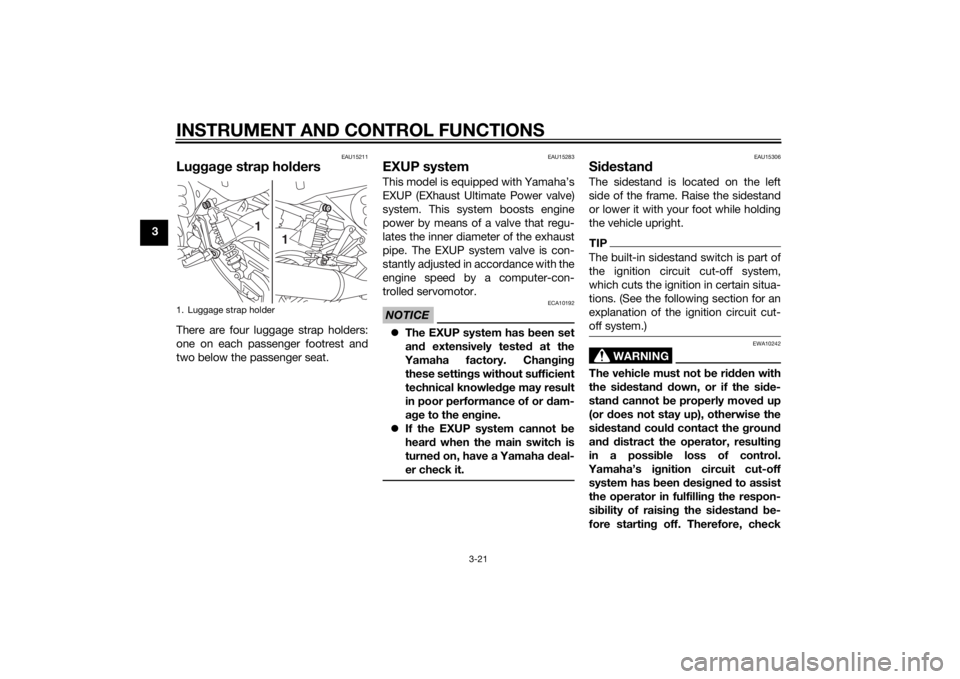
INSTRUMENT AND CONTROL FUNCTIONS
3-21
3
EAU15211
Luggage strap hol dersThere are four luggage strap holders:
one on each passenger footrest and
two below the passenger seat.
EAU15283
EXUP systemThis model is equipped with Yamaha’s
EXUP (EXhaust Ultimate Power valve)
system. This system boosts engine
power by means of a valve that regu-
lates the inner diameter of the exhaust
pipe. The EXUP system valve is con-
stantly adjusted in accordance with the
engine speed by a computer-con-
trolled servomotor.NOTICE
ECA10192
The EXUP system has been set
an d extensively teste d at the
Yamaha factory. Chan gin g
these settin gs without sufficient
technical knowledg e may result
in poor performance of or dam-
a g e to the en gine.
If the EXUP system cannot be
hear d when the main switch is
turne d on, have a Yamaha d eal-
er check it.
EAU15306
Si destan dThe sidestand is located on the left
side of the frame. Raise the sidestand
or lower it with your foot while holding
the vehicle upright.TIPThe built-in sidestand switch is part of
the ignition circuit cut-off system,
which cuts the ignition in certain situa-
tions. (See the following section for an
explanation of the ignition circuit cut-
off system.)
WARNING
EWA10242
The vehicle must not be ri dden with
the si destan d d own, or if the si de-
stan d cannot b e properly moved up
(or does not stay up), otherwise the
si destan d coul d contact the groun d
an d d istract the operator, resultin g
in a possi ble loss of control.
Yamaha’s i gnition circuit cut-off
system has been desi gne d to assist
the operator in fulfillin g the respon-
si bility of raisin g the si destan d b e-
fore startin g off. Therefore, check
1. Luggage strap holder
1
1
U2PNE0E0.book Page 21 Tuesda y, September 16, 2014 4:15 PM
Page 37 of 98

INSTRUMENT AND CONTROL FUNCTIONS
3-22
3
this system re
gularly an d have a
Yamaha dealer repair it if it does not
function properly.
EAU44893
I g nition circuit cut-off systemThe ignition circuit cut-off system
(comprising the sidestand switch,
clutch switch and neutral switch) has
the following functions.
It prevents starting when the
transmission is in gear and the
sidestand is up, but the clutch le-
ver is not pulled.
It prevents starting when the
transmission is in gear and the
clutch lever is pulled, but the side-
stand is still down.
It cuts the running engine when
the transmission is in gear and the
sidestand is moved down.
Periodically check the operation of the
ignition circuit cut-off system accord-
ing to the following procedure.
U2PNE0E0.book Page 22 Tuesda y, September 16, 2014 4:15 PM
Page 38 of 98
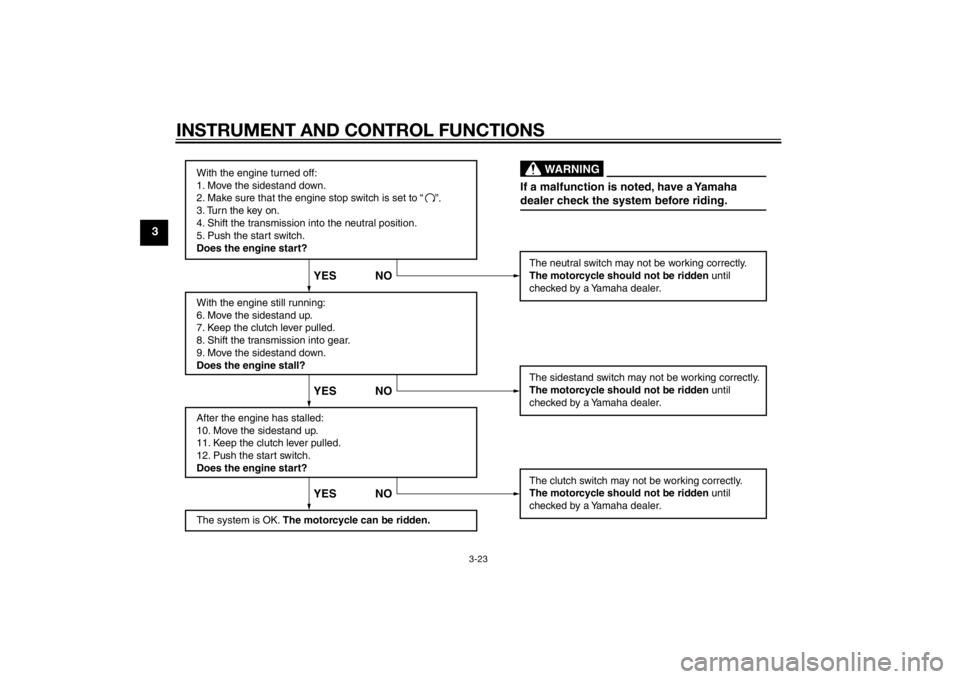
INSTRUMENT AND CONTROL FUNCTIONS
3-23
3
With the engine turned off:
1. Move the sidestand down.
2. Make sure that the engine stop switch is set to “
3. Turn the key on.
4. Shift the transmission into the neutral position.
5. Push the start switch.
Does the engine start?
With the engine still running:
6. Move the sidestand up.
7. Keep the clutch lever pulled.
8. Shift the transmission into gear.
9. Move the sidestand down.
Does the engine stall?
After the engine has stalled:
10. Move the sidestand up.
11. Keep the clutch lever pulled.
12. Push the start switch.
Does the engine start?
The system is OK. The motorcycle can be ridden. The neutral switch may not be working correctly.
The motorcycle should not be ridden
until
checked by a Yamaha dealer.
The sidestand switch may not be working correctly.
The motorcycle should not be ridden until
checked by a Yamaha dealer.
The clutch switch may not be working correctly.
The motorcycle should not be ridden until
checked by a Yamaha dealer.
YES NO YES NO YES NO
If a malfunction is noted, have a Yamaha
dealer check the system before riding.
WARNING
”.
U2PNE0E0.book Page 23 Tuesda y, September 16, 2014 4:15 PM
Page 39 of 98
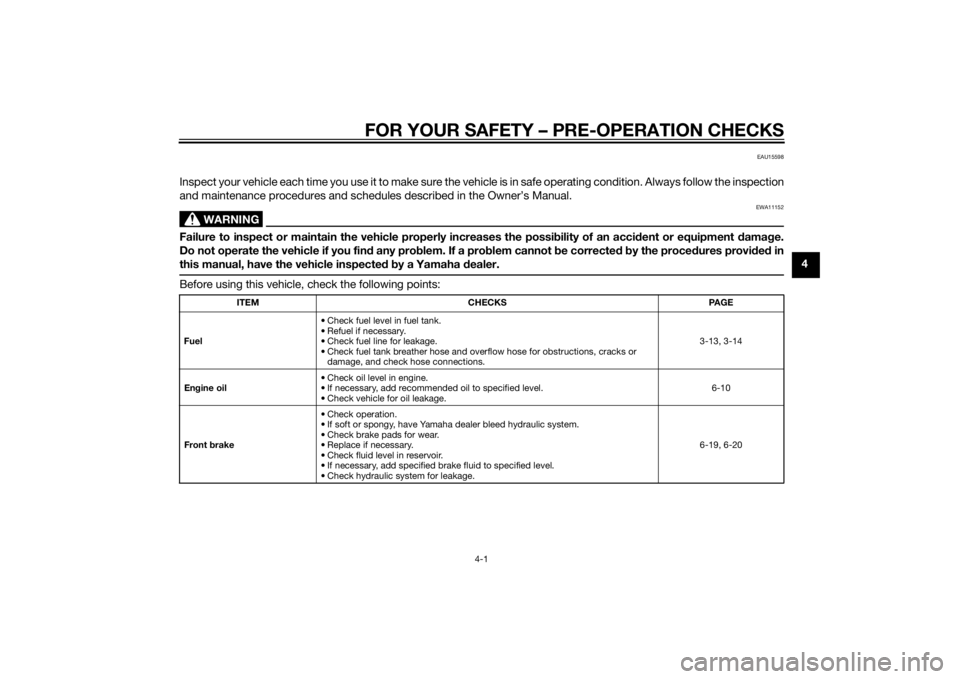
FOR YOUR SAFETY – PRE-OPERATION CHECKS
4-1
4
EAU15598
Inspect your vehicle each time you use it to make sure the vehicle is in safe operating condition. Always follow the inspection
and maintenance procedures and schedules described in the Owner’s Manual.
WARNING
EWA11152
Failure to inspect or maintain the vehicle properly increases the possibility of an accident or equipment d amage.
Do not operate the vehicle if you fin d any pro blem. If a pro blem cannot b e corrected b y the proce dures provi ded in
this manual, have the vehicle inspecte d b y a Yamaha dealer.Before using this vehicle, check the following points:
ITEM CHECKS PAGE
Fuel • Check fuel level in fuel tank.
• Refuel if necessary.
• Check fuel line for leakage.
• Check fuel tank breather hose and overflow hose for obstructions, cracks or
damage, and check hose connections. 3-13, 3-14
En gine oil • Check oil level in engine.
• If necessary, add recommended oil to specified level.
• Check vehicle for oil leakage. 6-10
Front brake • Check operation.
• If soft or spongy, have Yamaha dealer bleed hydraulic system.
• Check brake pads for wear.
• Replace if necessary.
• Check fluid level in reservoir.
• If necessary, add specified brake fluid to specified level.
• Check hydraulic system for leakage. 6-19, 6-20
U2PNE0E0.book Page 1 Tuesday, September 16, 2014 4:15 PM
Page 40 of 98

FOR YOUR SAFETY – PRE-OPERATION CHECKS
4-2
4
Rear brake • Check operation.
• If soft or spongy, have Yamaha dealer bleed hydraulic system.
• Check brake pads for wear.
• Replace if necessary.
• Check fluid level in reservoir.
• If necessary, add specified brake fluid to specified level.
• Check hydraulic system for leakage. 6-19, 6-20
Clutch • Check operation.
• If soft or spongy, have Yamaha dealer bleed hydraulic system.
• Check fluid level in reservoir.
• If necessary, add specified brake fluid to specified level.
• Check hydraulic system for leakage. 6-18, 6-20
Throttle g rip • Make sure that operation is smooth.
• Check throttle grip free play.
• If necessary, have Yamaha dealer adjust throttle grip free play and lubricate ca-
ble and grip housing. 6-15, 6-24
Control ca bles • Make sure that operation is smooth.
• Lubricate if necessary. 6-24
Drive chain • Check chain slack.
• Adjust if necessary.
• Check chain condition.
• Lubricate if necessary.
6-22, 6-23
Wheels an d tires •Check for damage.
• Check tire condition and tread depth.
• Check air pressure.
• Correct if necessary.
6-15, 6-18
Brake an d shift pe dals • Make sure that operation is smooth.
• Lubricate pedal pivoting points if necessary. 6-24
Brake an d clutch levers • Make sure that operation is smooth.
• Lubricate lever pivoting points if necessary.
6-25
Si destan d • Make sure that operation is smooth.
• Lubricate pivot if necessary.
6-26
ITEM
CHECKS PAGE
U2PNE0E0.book Page 2 Tuesday, September 16, 2014 4:15 PM